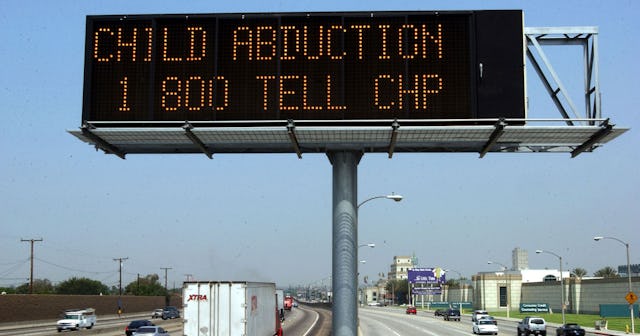The Real 9-Year-Old Abductee Behind Amber Alerts

Every time my phone goes off making that terrible blaring, beeping noise in the middle of the night, I get super annoyed. But in an instant, when I see that it’s not a weather warning but instead an Amber Alert, my heart sinks. As a Mom to two littles, I instantly put myself in the parents’ situation. I cannot even begin to imagine what it’s like to know your child is missing and have no idea where to find them.
The alerts we are sent when a child goes missing are AMBER alerts (America’s Missing: Broadcast Emergency Response). While we know what they are and why we get them, the story behind how they came to be isn’t as widely know. Amber alerts aren’t only an acronym for the above response. They were also named after a young girl, Amber Hagerman, who was abducted in 1996 in broad daylight. The story goes a little something like this. On January 13th, 1996, Amber and her brother went for a bike ride, and during their outing, Amber was abducted. There was only one witness to the crime who was able to give authorities a vague description of the assailant. Twenty-five years have passed, and Amber’s abductor (and murderer) has never been identified.
Yes, tragically, Amber’s body was found four days after her abduction. While her family is still seeking justice for her, they inspired a movement that has saved more than 1,000 children since its inception. What started off in Texas as a collaboration between law enforcement and broadcasting networks has grown to be a nationwide effort. So, let’s talk a little bit about these alerts. How do they work? What do you need to know if you find yourself reporting a missing child? Most importantly, what can we do to make sure our children stay safe?
How Do Amber Alerts Work?
Alex Wong/Getty
Your child is missing. You’ve searched high and low for them. They aren’t with their friends, and they’re not playing a painfully frightening game of hide-and-seek. First thing, call 911 and contact law enforcement right away. If any of y’all are true crime fans the way that I am, you know the more time goes by the harder it can be to locate the missing person. From there, they will determine if your missing child meets the criteria to issue an amber alert.
The criteria vary from state to state, but there are national guidelines. According to the Department of Justice, first, law enforcement must believe that your child has been abducted and is in imminent danger. Secondly, you need to describe your child and have information about the abduction. In the example of Amber Hagerman, there was one witness. While they couldn’t say for certain who took her, they were able to describe the abductor as well as the vehicle he grabbed her in.
This way, not only does it give law enforcement clues to begin their investigation, it allows the public to be on the lookout for a child, an adult, and/or a vehicle fitting these descriptions. Finally, your child must be a child aged 17 years or younger. You’ll also have to provide their information and description, which will be entered into a national system and the profile will be tagged as a Child Abduction case. Word of the abduction will be spread via an amber alert in hopes of someone, somewhere sees your child and law enforcement being able to rescue them. Amber alerts will pop up on our phones. They come up when people are watching regularly scheduled TV programming or on the radio. Sometimes they’re even on billboards with electronic advertising.
Can the alerts disrupt your day-to-day? Yeah, but have some humanity. A concern with the amber alert system was that if these notifications went out too often, the public would become desensitized to the seriousness of the incident. Please, don’t ignore amber (or silver) alerts when they come to your attention. It’s not that you have to drop everything and become a part-time investigator, but keeping an eye open or even being aware of the situation can be critical.
What We Can Do To Help
Alex Wong/Getty
As a parent, I tend to hover maybe more than I should. It’s not that I don’t trust my girls. They know not to talk to strangers, less get into their car. But like in the instance of Amber in 1996, abductors may physically force and kidnap their victims kicking and screaming.
Maybe I listen to too many Dateline podcasts, but one of my worst fears is that either of my children goes missing. You don’t have to freak your kid out to the point where they velcro themselves to you permanently, but make sure your kids know what to do in case you get separated. It’s an incredibly difficult conversation to have with your child about what to do, just in case. But the fact is, in 1996, Amber was only nine years old when she was abducted.
Since then, society has changed — for the better in some ways and worse in others. We have more technology when it comes to tracking our kids’ whereabouts via their phones or smart watches. But even with these advantages, there are still evil people in this world. There is an endless list of realities about this life we share with our children to keep them safe. It’s worth reminding ourselves, and our littles, that even with bad people in this world, there are ten times as many who are good.
This article was originally published on